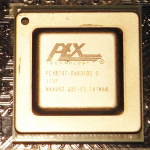I am fresh off my ninth discussion with a company that utilizes PLX PCIe switch chips in their designs and figure that I have enough data points where this is publishable. We often get asked what has slowed the adoption of NVMe drives everywhere and have at least part of the answer: Avago’s acquisition of PLX.
PLX was well-known as the industry go-to source for a specialized part: PCIe switches. Essentially think of these products as similar to network switches except that instead of Ethernet, the chips can take a number of PCIe uplink lanes (e.g. switch to CPU) and connect more downstream PCIe lanes to the devices. This is how you can have a server with 80 PCIe 3.0 lanes from the CPUs yet connect 24x PCIe 3.0 x4 drives (96 lanes total) to the system.

This over-subscription is common in the networking world but also works for other architectures (e.g. storage) since it is unlikely all devices are being fully utilized at all times.
 Adding a PLX PCIe switch is the way companies allow over-subscription of server PCIe buses. They became popular in the gaming community for expanding PCIe lanes for multiple GPU systems. In the server space, they are a major building block for PCIe based storage systems.
Adding a PLX PCIe switch is the way companies allow over-subscription of server PCIe buses. They became popular in the gaming community for expanding PCIe lanes for multiple GPU systems. In the server space, they are a major building block for PCIe based storage systems.
The Avago Acquisition
Avago’s acquisition strategy has largely been to purchase dominant companies with little competition. PLX is one of those companies with few competitive products.
We covered the PLX/ Avago impact on storage at last year’s Flash Memory Summit. That is a good primer on the acquisition and how technology is used in the storage industry.
How Pricing Was Impacted
Coming back to the conversations we have had, with low competition, Avago is able to dramatically increase prices. In each of our discussions we heard price increases of 3x or more under the Avago umbrella. We were also told that Avago would, after raising prices, offer to discount in order to gain market penetration in other parts of its portfolio.
The impact on the storage industry has been pronounced. With this base technology getting more expensive the NVMe ecosystem was more expensive and we are still waiting for price parity with SAS/ SATA solutions.
A Counter Point
One counter point that we heard was that companies could use flash tiering and did not need to have full disk shelves of NVMe SSDs. This is essentially the argument that customers did not need/ want the extra performance offered by NVMe.
What we saw at Flash Memory Summit 2016 is that customers indeed want NVMe SSDs. At FMS 2016 if it is not PCIe (or memory bus based) flash devices are considered a commodity. Given the cost of flash the industry is moving full speed to PCIe based storage (and gearing up for adding technology such as 3D XPoint.
Final Words
Avago/ Broadcom has made other acquisitions in the storage area. For example, it purchased LSI which makes the industry’s most widely adopted SAS controllers. From a business perspective, buying unique technology then raising prices is a great way to increase revenues quickly. It is also a great way to lower customer satisfaction (9 of 9 Avago customers said they were not happy with the change.) While this generation of NVMe storage may be focused on PCIe and PLX switches, 3D Xpoint has the potential to disrupt a large segment of this business. Our take is that this round of the PCIe/ NVMe storage generation architecture war has been won by Avago with its PLX acquisition.




